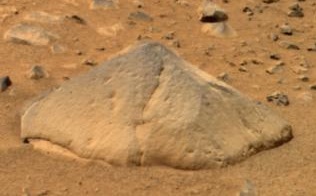Adirondack
Adirondack is the tae-name for Maurs Sploration Rinaboot Speerit's first target stane. Scientists chuist Adirondack tae be Speerit's first target stane raither than anither stane, cried Sashimi, that wad hae been a shorter, straucht-aheid drive. Speerit stravaiged the saundy maurtian terrain at Gusev Crater tae arrive in front o this fitbaw-sized stane on Januar 18, 2004, juist three days efter it successfully rowen aff the launder.

The stane wis selectit as Spirit's first target acause its dist-free, flet surface is ideally suitit for grindin. Clean surfaces forbye are better for examinin a stane's top coatin. Scientists cried the angular stane efter the Adirondack Ben reenge in New York.
The name "Adirondacks" comes fae the Mohawk ratirontaks, meanin "they eat trees", a name that the Mohawk gied tae the Algonquian-spikkin tribes o the Adirondack Mountains; whan there wisnae much fuid, the Algonquians wad eat the buds an bark o trees. [1]
Speerit's Mössbauer spectrometer detected a meeneral cried olivine, whilk disnae survive weathering weel. The lack o weatherin suggested bi the presence o olivine micht be evidence that the scaup stymes are finely ground volcanic material. Anither possible explanation is that the scaup layer whaur the measurements wis taen is extremely thin, an the olivine is actually in a stane unner the scaup. Speerit haes forbye retourned microscopic images an Mössbauer spectrometer readins o Adirondack taen the day afore the rinaboot developed computer an communication problems on Januar 22, 2004. Baith are wanprecedentit investigations o ony stane on anither planet. The microscopic images indicate Adirondack is a haurd, crystalline stane. The peends lairge an smaa in Adirondack's electromagnetic spectrum reveal that the meenerals in the stane include olivine, pyroxene an magnetite - a common composeetion in volcanic basalt stanes on Earth.
References eedit
- ↑ Donaldson, Alfred L., A History of the Adirondacks, New York: Century, 1921. ISBN 0-916346-26-8. (reprint), pp. 34-35